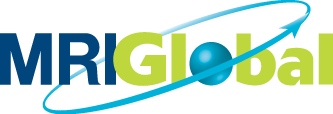MRIGlobal
 | |
Formerly called | Midwest Research Institute |
|---|---|
| Nonprofit scientific research institute | |
| Industry | |
| Founded | Kansas City, Missouri (June 17, 1944) |
| Founder | Kansas City-area business leaders |
| Headquarters |
425 Volker Boulevard Kansas City, Missouri, United States |
Area served | Worldwide |
| Services | |
Number of employees | 550 (in FY13)[1] |
| Website |
www |
MRIGlobal is an independent, not-for-profit, contract research organization based in Kansas City, Missouri, with regional offices in Virginia, Maryland and Florida. In addition to its own research laboratories, MRIGlobal operates research facilities for the Department of Energy and the Department of Defense.[1]
MRIGlobal conducts programs in the areas of molecular diagnostics, antimicrobial resistance, therapeutics, engineering, mobile laboratories, CBRNE technology development and countermeasures, chemical testing facilities, real-time biosurveillance, national security and defense, energy and the environment, and agriculture and food safety.,[1][2] The purpose of MRIGlobal is to provide solutions through scientific research, technology development, and technical services for the benefit of government, industry, and the public.
History[3]
Foundation
Founded in 1944 during World War II as Midwest Research Institute, the organization's initial mission was to find a way to convert the ammonium nitrate military ordnance plants in Galena, Kansas, Parsons, Kansas, DeSoto, Kansas and El Dorado, Arkansas to peaceful uses of creating fertilizer. Among the nine founders was Kenneth A. Spencer who would make a fortune from the Jayhawk Plant in Galena. Spencer would be chairman of the Institute from 1954 to 1957, and donated money for the Kenneth A. Spencer Laboratories Building and the Spencer Auditorium at MRIGlobal.[4]
MRIGlobal was located initially in the former Westport, Missouri City Hall at 40th Terrace and Pennsylvania. That building was torn down in 1955 at which time MRIGlobal moved into its current Kansas City headquarters, facing the Nelson Art Gallery, and adjacent to University of Missouri - Kansas City and the headquarters of Russell Stovers candy.[5]
Rapid expansion
MRIGlobal obtained its first contract with NASA in 1961 and its first U.S. Arms Control and Disarmament Agency contract in 1964. In the 1970s, the organization began working for the U.S. Environmental Protection Agency developing tests to detect and measure pollutants.[6]
Expansion and growth continued in the 1980s. In 1982, a venture group was created to commercialize MRIGlobal’s inventions. Major projects included engineering lightweight thermoelectric cooling devices for U.S. Army aircraft. This technology earned an R&D 100 Award, and was used in Operation Desert Storm to keep flight personnel cool while operating in warm climates.[7]
Throughout the next two decades, MRIGlobal expanded its operations, adding locations in Palm Bay, Florida, in 1999; Rockville, Maryland, in 2002; and Frederick, Maryland, in 2003.[7]
In January 2015, MRIGlobal powered their first-ever online detection database, CBRNE Tech Index.
Recent history
On March 1, 2011, the organization was renamed MRIGlobal.[3][8]
In 2014, MRIGlobal launched CBRNE Tech Index, a comprehensive database of Chemical, Biological, Radiological, Nuclear, and Explosive (CBRNE) detection equipment.[9]
Projects[3]
- Coating process for M&M Candies permitting the coating of 3,300 pounds (1,500 kg) of chocolate centers every hour (1950s)[10]
- Soluble coffee for J.A. Folger a forerunner of auto drip coffeemaker (1950s)[11]
- National Renewable Energy Laboratory (managed since its start in 1977 as MRIGlobal is part of the Alliance for Sustainable Energy) (1970s)
- Maintaining the National Cancer Institute Repository (since the 1980s)
- Development of a thermoelectric cooling system for flight personnel and astronauts (1990s)
- Ethanol conversion process for the entire corn plant (cob, stalk and leaves—not just the kernels) (in conjunction with NREL and DuPont) (2000s)
- Advanced air sampler to detect trace levels of DNA from anthrax spores (2000s)
References
- 1 2 3 "MRIGlobal 2013 Annual Report" (PDF). mriglobal.org. Retrieved 2014-07-21.
- ↑ "MRIGlobal 2014 Annual Report" (PDF). mriglobal.org. Retrieved 2015-01-16.
- 1 2 3 "History brochure" (PDF). MRIGlobal. Retrieved 1 November 2013.
- ↑ "Search KU Finding Aids". Ead.diglib.ku.edu. Retrieved 2011-03-01.
- ↑ "Index". Westporthistorical.org. Retrieved 2011-03-01.
- ↑ Everly, Steve (August 19, 2014). "MRIGlobal: An institution on the edge". Kansas City Star. Retrieved August 19, 2014.
- 1 2 Kimball, Charles N. (1985). Midwest Research Institute: Some Recollections of the First 30 Years, 1945-1975. Kansas City, MO: Midwest Research Institute.
- ↑ Twiddy, David (March 1, 2001). "Midwest Research Institute changes name to MRIGlobal". Kansas City Business Journal. Retrieved March 1, 2001.
- ↑ "MRIGlobal Launches CBRNE Tech Index™". www.mriglobal.org. Retrieved 2015-07-21.
- ↑ "MRI Breakthroughs". Mriresearch.org. September 11, 2001. Archived from the original on July 2, 2008. Retrieved January 15, 2010.
- ↑ Everly, Steve (August 19, 2014). "Midwest Research Institute, now MRIGlobal, has been making its mark for 70 years". Kansas City Star. Retrieved August 21, 2014.
External links
Coordinates: 39°02′17″N 94°34′53″W / 39.038111°N 94.581251°W